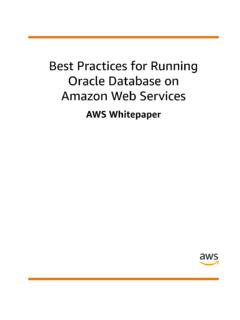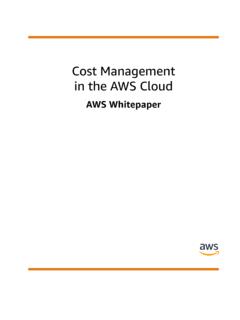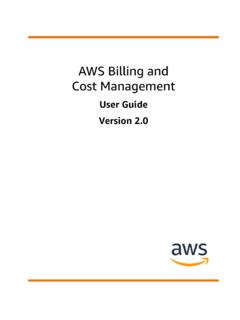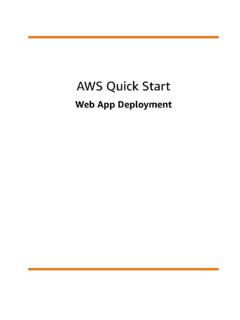Transcription of AWS Storage Optimization - AWS Whitepaper
1 AWS Storage OptimizationAWS WhitepaperAWS Storage Optimization AWS WhitepaperAWS Storage Optimization : AWS WhitepaperCopyright 2018 Amazon Web Services, Inc. and/or its affiliates. All rights 's trademarks and trade dress may not be used in connection with any product or service that is not Amazon's, in any mannerthat is likely to cause confusion among customers, or in any manner that disparages or discredits Amazon. All other trademarks notowned by Amazon are the property of their respective owners, who may or may not be affiliated with, connected to, or sponsored Storage Optimization AWS WhitepaperTable of ContentsAWS Storage Optimization .. 1 Abstract .. 1 Introduction .. 1 Identify Your Data Storage Requirements .. 2 AWS Storage Services .. 3 Object Storage .. 3 Block 3 File 4 Optimize Amazon S3 Storage .
2 6 Optimize Amazon EBS Storage .. 8 Delete Unattached Amazon EBS Volumes .. 8 Resize or Change the EBS Volume Type .. 8 Delete Stale Amazon EBS Snapshots .. 9 Storage Optimization is an Ongoing Process .. 11 Resources .. 12 Document 13 AWS Glossary .. 14iiiAWS Storage Optimization AWS WhitepaperAbstractAWS Storage OptimizationPublication date: March 2018 (Document Details (p. 13))AbstractThis is the last in a series of whitepapers designed to support your cloud journey. This paper seeksto empower you to maximize value from your investments, improve forecasting accuracy and costpredictability, create a culture of ownership and cost transparency, and continuously measure youroptimization paper discusses how to choose and optimize AWS Storage services to meet your data Storage needsand help you save tend to think of data Storage as an ancillary service and do not optimize Storage afterdata is moved to the cloud.
3 Many also fail to clean up unused Storage and let these services run for days,weeks, and even months at significant cost. According to this blog post by RightScale, up to 7% of allcloud spend is wasted on unused Storage volumes and old snapshots (copies of Storage volumes).AWS offers a broad and flexible set of data Storage options that let you move between different tiers ofstorage and change Storage types at any time. This Whitepaper discusses how to choose AWS storageservices that meet your data Storage needs at the lowest cost. It also discusses how to optimize theseservices to achieve balance between performance, availability, and Storage Optimization AWS WhitepaperIdentify Your Data StorageRequirementsTo optimize Storage , the first step is to understand the performance profile for each of your should conduct a performance analysis to measure input/output operations per second (IOPS),throughput, and other Storage services are optimized for different Storage scenarios there is no single data storageoption that is ideal for all workloads.
4 When evaluating your Storage requirements, consider data storageoptions for each workload following questions can help you segment data within each of your workloads and determine yourstorage requirements: How often and how quickly do you need to access your data? AWS offers Storage options and pricingtiers for frequently accessed, less frequently accessed, and infrequently accessed data. Does your data store require high IOPS or throughput? AWS provides categories of Storage that areoptimized for performance and throughput. Understanding IOPS and throughput requirements willhelp you provision the right amount of Storage and avoid overpaying. How critical (durable) is your data? Critical or regulated data needs to be retained at almost anyexpense and tends to be stored for a long time.
5 How sensitive is your data? Highly sensitive data needs to be protected from accidental and maliciouschanges, not just data loss or corruption. Durability, cost, and security are equally important toconsider. How large is your data set? Knowing the total size of the data set helps in estimating Storage capacityand cost. How transient is your data? Transient data is short-lived and typically does not require high durability.(Note: Durability refers to average annual expected data loss.) Clickstream and Twitter data are goodexamples of transient data. How much are you prepared to pay to store the data? Setting a budget for data Storage will informyour decisions about Storage Storage Optimization AWS WhitepaperObject storageAWS Storage ServicesChoosing the right AWS Storage service for your data means finding the closest match in terms of dataavailability, durability, and refers to a Storage volume s ability to deliver data upon request.
6 Performancerefers to the number of IOPS or the amount of throughput (measured in megabytes per second)that the Storage volume can offers three broad categories of Storage services: object, block, and file Storage . Each offeringis designed to meet a different Storage requirement, which gives you flexibility to find the solution thatworks best for your Storage storageAmazon Simple Storage Service (Amazon S3) is highly durable, general-purpose object Storage thatworks well for unstructured data sets such as media content. Amazon S3 provides the highest level ofdata durability and availability on the AWS Cloud. There are three tiers of Storage : one each for hot,warm, or cold data. In terms of pricing, the colder the data, the cheaper it is to store, and the costlier itis to access when needed.
7 You can easily move data between these Storage options to optimize storagecosts: Amazon S3 Standard The best Storage option for data that you frequently access. Amazon S3delivers low latency and high throughput and is ideal for use cases such as cloud applications, dynamicwebsites, content distribution, gaming, and data analytics. Amazon S3 Standard - Infrequent Access (Amazon S3 Standard - IA) Use this Storage option fordata that you access less frequently, such as long-term backups and disaster recovery. It offers cheaperstorage over time, but higher charges to retrieve or transfer data. Amazon Glacier Designed for long-term Storage of infrequently accessed data, such as end-of-lifecycle, compliance, or regulatory backups. Different methods of data retrieval are available atvarious speeds and cost.
8 Retrieval can take from a few minutes to several following table shows comparative pricing for Amazon S3 Pricing*Per Gigabyte-MonthAmazon S3$ S3 Standard - IA$ (plus $ retrieval charge)Amazon Glacier$ *Based on US East (N. Virginia) storageAmazon Elastic Block Store (Amazon EBS) volumes provide a durable block- Storage option for usewith EC2 instances. Use Amazon EBS for data that requires long-term persistence and quick access atguaranteed levels of performance. There are two types of block Storage : solid-state-drive (SSD) storageand hard-disk-drive (HDD) Storage Optimization AWS WhitepaperFile storageSSD Storage is optimized for transactional workloads where performance is closely tied to IOPS. Thereare two SSD volume options to choose from: EBS Provisioned IOPS SSD (io1) Best for latency-sensitive workloads that require specific minimum-guaranteed IOPS.
9 With io1 volumes, you pay separately for provisioned IOPS, so unless you need highlevels of provisioned IOPS, gp2 volumes are a better match at lower cost. EBS General Purpose SSD (gp2) Designed for general use and offer a balance between cost Storage is designed for throughput-intensive workloads such as data warehouses and logprocessing. There are two types of HDD volumes: Throughput Optimized HDD (st1) Best for frequently accessed, throughput-intensive workloads. Cold HDD (sc1) Designed for less frequently accessed, throughput-intensive following table shows comparative pricing for Amazon EBS Pricing*Per Gigabyte-MonthGeneral Purpose SSD (gp2)$ per GB-month of provisioned storageProvisioned IOPS SSD (io1)$ per GB-month of provisioned Storage , plus$ per provisioned IOPS-monthThroughput Optimized HDD (st1)$ per GB-month of provisioned storageCold HDD (sc1)$ per GB-month of provisioned storageAmazon EBS Snapshots to Amazon S3$ per GB-month of data stored*Based on US East (N.)
10 Virginia) storageAmazon Elastic File System (Amazon EFS) provides simple, scalable file Storage for use with EC2instances. Amazon EFS supports any number of instances at the same time. Its Storage capacity can scalefrom gigabytes to petabytes of data without needing to provision Storage . Amazon EFS is designed forworkloads and applications such as big data, media-processing workflows, content management, andweb serving. Amazon EFS also supports file synchronization capabilities so that you can efficiently andsecurely synchronize files from on-premises or cloud file systems to Amazon EFS at speeds of up to 5times faster than standard Linux copy S3 and Amazon EFS allocate Storage based on your usage and you pay for what you , for EBS volumes, you are charged for provisioned (allocated) Storage whether or not you useit.















